-p-2000.png)


How to Use LinkedIn for B2B Lead Generation

The sole focus of any business that wants to grow and thrive in the ever-competitive world is lead generation.
What else can be done to drive a consistent revenue? You might be having a number of lead-generation tactics in place. Some of these marketing and sales tactics work wonders in generating leads, while some of those might not be commendable as they fail to generate leads. So, your focus has to be on having well-defined strategies in place to ensure lead generation.
If you are looking for well-defined tactics to generate B2B leads on LinkedIn, you are at the right place.
How to Generate B2B Leads on LinkedIn?
According to a LinkedIn article, 82% of B2B marketers use LinkedIn for lead generation and over 60% of them say that it helps them generate leads, over two times more than the other social media channels.
LinkedIn’s professional targeting filters and in-depth analytics will connect you with your business prospects and bring you results. Over time, you will realize that lead generation with LinkedIn is easier when compared with other social media marketing channels.
1. Understanding the buyer persona
Unlike the B2C buyer journey, the B2B buyer process is complex now, more than ever.
According to the guide to lead generation on LinkedIn, with a rise in the number of stakeholders involved, the B2B buyer’s journey is more self-guided and longer. The purchase decisions are influenced by not just one person or multiple people; these are determined by individuals or teams from different departments.
What you can do is generate trust to build a long-term relationship that lasts over years.
2. Narrowing the scope of your campaigns
How to convert audiences and how to reach them? You can start by creating buyer personas – who share sets of attributes with your potential prospects. From there, narrow the scope of your campaigns and ensure that each engagement counts.
Once you narrow the scope of your campaigns, zero in on the best of your prospects. For this, it is recommended that you layer your targeting parameters, which will help you to find the sweet spots but also maintain a sizable audience.
You can use LinkedIn’s extensive filters that will help you with mixing and matching. Testing early in your campaign for sweet spots will help you understand where you need to look for.
3. Identifying sweet spots to generate leads
From mixing and matching, you will be able to identify the sweet spots that you need. LinkedIn’s matched audiences feature will bolster your lead generation efforts in identifying the ideal audience.
Here are some of the ways to identify your audience:
1. Website retargeting
Once a user visits your website, it is clear that the user has an interest in your products or services. Choose such users on LinkedIn and serve ads to them.
2. Account targeting
Next, you can upload a list of target companies that match with more than 8 million LinkedIn pages for a strategic account-based marketing approach.
3. Contact targeting
In this, you can market to your own existing contact lists via LinkedIn ads.
Time to look at the bigger picture.
B2B businesses have learned that focusing on multiple departments rather than one individual within an organization is the best way to generate leads. This approach will go a long way in helping you reach the right people as many stakeholders and departments make purchase decisions jointly.
According to a LinkedIn research, the typical B2B buying decision is influenced mostly by five departments:
Accounting, Business Development, Finance, IT, and Operations. When you are developing lead generation campaigns, make sure you are catering these to the various departments of an organization. Also, customized messaging to each department will be another step in taking your relationship ahead.
4. Thought leadership
Developing thought leadership content is resourceful at driving strategic brand awareness while also helping to generate leads as it is of significant importance to varying decision-makers and influencers at various levels of the organization.
According to a study, over 70% of buyers look for a company that has been constantly adding value through the purchase journey. Add value to the services you are offering by delivering useful information and guidance that will fit right into your prospects’ needs, helping to solve their problems. Using LinkedIn would be key to implementing your thought leadership strategy.
Users are looking for brands to help them and if you can provide that help at the right time, you are already looking at your potential prospects.
Why choose LinkedIn to generate B2B leads?
As discussed earlier, B2B is nothing like B2C. The decisions are complex and so stakeholders need expert consultation before they move any further. A typical buyer consumes more than 7 pieces of content before they make a decision.
LinkedIn is a social media channel, with over 570 million professionals (2.8 million decision-makers and 260,000 C-suite executives) from around the world and across various industry verticals. Here, professionals from all over the world meet to share meaningful and insightful content with each other.
What sets apart LinkedIn from other channels for B2B lead generation?
Data: You can get data related to position, seniority, industry location to identify the people you need to contact.
Acceptance: LinkedIn is used for researching business topics and most people are looking for ways to expand their careers – which makes LinkedIn a receptive platform for B2B messaging.
Familiarize yourself with the fundamentals of how branding works on LinkedIn and tweak your lead generation tactics with creative ideas to reach out to people.
Are you looking for a top Social Media Agency?
Seattle New Media is a website design and digital marketing agency, offering all kinds of website design and digital marketing services to our clients across the world. For a free consultation, reach out to us today

FAQ
Editorial Team
Publisher
The sole focus of any business that wants to grow and thrive in the ever-competitive world is lead generation.
What else can be done to drive a consistent revenue? You might be having a number of lead-generation tactics in place. Some of these marketing and sales tactics work wonders in generating leads, while some of those might not be commendable as they fail to generate leads. So, your focus has to be on having well-defined strategies in place to ensure lead generation.
If you are looking for well-defined tactics to generate B2B leads on LinkedIn, you are at the right place.
How to Generate B2B Leads on LinkedIn?
According to a LinkedIn article, 82% of B2B marketers use LinkedIn for lead generation and over 60% of them say that it helps them generate leads, over two times more than the other social media channels.
LinkedIn’s professional targeting filters and in-depth analytics will connect you with your business prospects and bring you results. Over time, you will realize that lead generation with LinkedIn is easier when compared with other social media marketing channels.
1. Understanding the buyer persona
Unlike the B2C buyer journey, the B2B buyer process is complex now, more than ever.
According to the guide to lead generation on LinkedIn, with a rise in the number of stakeholders involved, the B2B buyer’s journey is more self-guided and longer. The purchase decisions are influenced by not just one person or multiple people; these are determined by individuals or teams from different departments.
What you can do is generate trust to build a long-term relationship that lasts over years.
2. Narrowing the scope of your campaigns
How to convert audiences and how to reach them? You can start by creating buyer personas – who share sets of attributes with your potential prospects. From there, narrow the scope of your campaigns and ensure that each engagement counts.
Once you narrow the scope of your campaigns, zero in on the best of your prospects. For this, it is recommended that you layer your targeting parameters, which will help you to find the sweet spots but also maintain a sizable audience.
You can use LinkedIn’s extensive filters that will help you with mixing and matching. Testing early in your campaign for sweet spots will help you understand where you need to look for.
3. Identifying sweet spots to generate leads
From mixing and matching, you will be able to identify the sweet spots that you need. LinkedIn’s matched audiences feature will bolster your lead generation efforts in identifying the ideal audience.
Here are some of the ways to identify your audience:
1. Website retargeting
Once a user visits your website, it is clear that the user has an interest in your products or services. Choose such users on LinkedIn and serve ads to them.
2. Account targeting
Next, you can upload a list of target companies that match with more than 8 million LinkedIn pages for a strategic account-based marketing approach.
3. Contact targeting
In this, you can market to your own existing contact lists via LinkedIn ads.
Time to look at the bigger picture.
B2B businesses have learned that focusing on multiple departments rather than one individual within an organization is the best way to generate leads. This approach will go a long way in helping you reach the right people as many stakeholders and departments make purchase decisions jointly.
According to a LinkedIn research, the typical B2B buying decision is influenced mostly by five departments:
Accounting, Business Development, Finance, IT, and Operations. When you are developing lead generation campaigns, make sure you are catering these to the various departments of an organization. Also, customized messaging to each department will be another step in taking your relationship ahead.
4. Thought leadership
Developing thought leadership content is resourceful at driving strategic brand awareness while also helping to generate leads as it is of significant importance to varying decision-makers and influencers at various levels of the organization.
According to a study, over 70% of buyers look for a company that has been constantly adding value through the purchase journey. Add value to the services you are offering by delivering useful information and guidance that will fit right into your prospects’ needs, helping to solve their problems. Using LinkedIn would be key to implementing your thought leadership strategy.
Users are looking for brands to help them and if you can provide that help at the right time, you are already looking at your potential prospects.
Why choose LinkedIn to generate B2B leads?
As discussed earlier, B2B is nothing like B2C. The decisions are complex and so stakeholders need expert consultation before they move any further. A typical buyer consumes more than 7 pieces of content before they make a decision.
LinkedIn is a social media channel, with over 570 million professionals (2.8 million decision-makers and 260,000 C-suite executives) from around the world and across various industry verticals. Here, professionals from all over the world meet to share meaningful and insightful content with each other.
What sets apart LinkedIn from other channels for B2B lead generation?
Data: You can get data related to position, seniority, industry location to identify the people you need to contact.
Acceptance: LinkedIn is used for researching business topics and most people are looking for ways to expand their careers – which makes LinkedIn a receptive platform for B2B messaging.
Familiarize yourself with the fundamentals of how branding works on LinkedIn and tweak your lead generation tactics with creative ideas to reach out to people.
Are you looking for a top Social Media Agency?
Seattle New Media is a website design and digital marketing agency, offering all kinds of website design and digital marketing services to our clients across the world. For a free consultation, reach out to us today
FAQ
Editorial Team
Publisher




Hi, I'm Mike!
If you are enjoying the article, feel free to subscribe to our monthly newsletter.
If you have any project requirements, please contact us.




.png)









